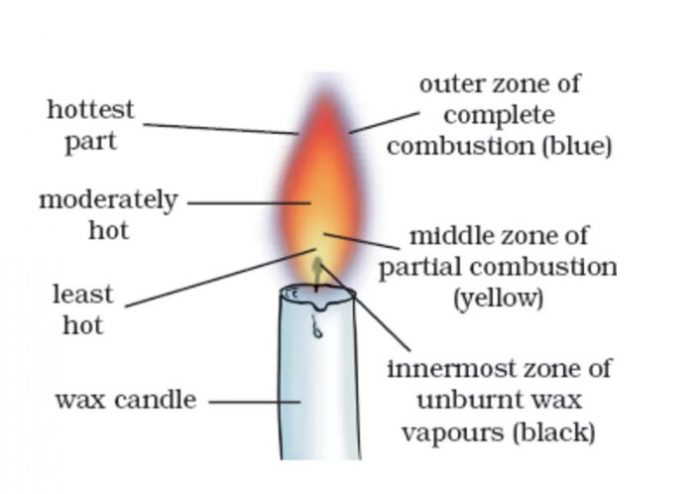Class 8 Science Chapter 6 |
Combustion and Flame NCERT Solutions
1. List conditions under which combustion can take place.
Answer:
The conditions required for combustion to take place are:
1) Presence of fuel
2) Air or oxygen
3) Ignition temperature(Minimum temperature at which substance catches fire)
2. Fill in the blanks.
(a) Burning of wood and coal causes _____ of air.
(b) A liquid fuel, used in homes is_______ .
(c) Fuel must be heated to its______ _______ before it starts burning.
(d) Fire produced by oil cannot be controlled by ______.
Answer:
(a) Burning of wood and coal causes pollution of air.
(b) A liquid fuel, used in homes is liquefied petroleum gas (LPG) .
(c) Fuel must be heated to its before it ignition temperature starts burning.
(d) Fire produced by oil cannot be controlled by water.
3. Explain how the use of CNG in automobiles has reduced pollution in our cities.
Answer:
CNG is a cleaner fuel. CNG produces very small amounts of harmful products like Sulphur dioxide, oxides of nitrogen, oxides of sulphur. Combustion of fuels causes formation of unburnt carbon particles along with harmful gases. These causes pollution and respiratory problems.
4. Compare LPG and wood as fuels
| LPG | Wood |
| 1) It produces more energy | It produces less energy |
| 2)The calorific value of LPG is 55000 KJ/Kg | The calorific value of wood is 17000-22000 KJ/Kg |
| 3) It causes no pollution | It causes pollution |
| 4) It leaves no residue | It leaves ash as residue |
| 5) It is easy to store and transport | It is difficult to store and transport |
5. Give reasons.
(a) Water is not used to control fires involving electrical equipment.
Answer:
Water cannot be used to control fires involving electrical equipment because water is a good conductor of electricity.
(b) LPG is a better domestic fuel than wood.
Answer:
LPG is a better domestic fuel than wood due to:
- It has higher calorific value, so it produces much more heat on burning than an equal mass of wood.
- It burns without leaving behind any smoke.
- It burns completely without leaving behind any solid residue but wood leaves behind a lot of ash on burning.
7. Name the unit in which the calorific value of a fuel is expressed.
Answer:
The calorific value of a fuel is expressed in a unit called kilojoule per kg (kJ/kg).
8. Explain how CO2 is able to control fires.
Answer:
Carbon dioxide is denser than air and forms a layer around the burning substance.It covers the fire like a blanket due to which fresh air cannot reach the burning substance.The burning substance does not get oxygen of air and hence stops burning.
9. It is difficult to burn a heap of green leaves but dry leaves catch fire easily. Explain.
Answer: A heap of green leaves contains a lot of moisture in it, hence its ignition temperature is high. Therefore it is difficult to catch fire.But dry leaves have no moisture content in it, hence its ignition temperature is low. Therefore it catches fire easily.
10. Which zone of a flame does a goldsmith use for melting gold and silver and why?
Answer:
Goldsmith uses the outermost zone of the flame for melting gold and silver because it is the hottest zone (complete combustion) of the flame.
11. In an experiment 4.5 kg of a fuel was completely burnt. The heat produced
was measured to be 180,000 kJ. Calculate the calorific value of the fuel.
Answer:
=40000 KJ/Kg
12. Can the process of rusting be called combustion? Discuss.
Answer:
Combustion is a chemical process in which a substance reacts with oxygen to release energy in the form heat or light.Rusting is a very slow process as compared to combustion and the heat evolve in combustion is much more than rusting. Rusting can take place at room temperature whereas combustion need an ignition temperature.
13. Abida and Ramesh were doing an experiment in which water was to be
heated in a beaker. Abida kept the beaker near the wick in the yellow part
of the candle flame. Ramesh kept the beaker in the outermost part of the
flame. Whose water will get heated in a shorter time?
Answer:
Rakesh’s water will get heated in a shorter time because water placed in the outermost part of the flame is non-luminous which is regarded as the hottest part of the flame. However, Abida who placed the beaker in the luminous flame (yellow flame)is comparatively less hot.


Well good website for getting and understanding solutions very well.
good
Very good
Very nice website